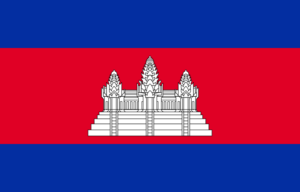The Khmer Kingdom ruled over Cambodia from 900 to 1400 AD, which is considered to be the most illustrious era in its history. For a period of its history, the Khmer Kingdom governed the region and was Southeast Asia’s biggest empire. At the height of their supremacy, it’s probable that more than a million people resided in the capital city of Angkor. The most well-known of the magnificent temples built here is Angkor Wat. The Khmer Kingdom fell apart in the fifteenth century and never recovered its former splendor.
France began to protectorate Cambodia in 1863. Up until November 9, 1953, when it attained complete independence, this persisted for almost a century.
Early in the 1970s, Cambodia was drawn into the Vietnam War. However, after the war, things only became worse. A gang known as the Khmer Rouge, commanded by Pol Pot, took control. Inhumane working conditions were pressed upon the populace, and 1 million Cambodians—or about 12% of the total—were slaughtered.
| Capital | Phnom Penh |
| Population | 16,979,082 (Source: 2023 worldometer) |
| Major Cities | Phnom Penh, Takeo, Siem Reap, Battambang, Poipet, Kampong Chhnang, Kampong Saom, Kampong Cham, Pursat, Ta Khmau |
| Borders | Vietnam to the east, Laos in the northeast, Thailand in the west and northwest |
| Gross Domestic Product (GDP) | $29,956,769,529 (2022 worldometer) |
| Currency | riel (KHR) |

Cambodia Major Industries: tourism, garments, rice milling, fishing, wood and wood products, rubber, cement, gem mining, textiles
Cambodia Agricultural Products: rice, rubber, corn, vegetables, cashews, tapioca
Cambodia Natural Resources: oil and gas, timber, gemstones, some iron ore, manganese, phosphates, hydropower potential
Cambodia Major Exports: clothing, timber, rubber, rice, fish, tobacco, footwear
Cambodia Major Imports: petroleum products, cigarettes, gold, construction materials, machinery, motor vehicles, pharmaceutical products
Total Size of Cambodia: 181,035 km² (source: wikipedia)
Geographical Low Point of Cambodia: Gulf of Thailand 0 m
Geographical High Point of Cambodia: Phnum Aoral 1,810 m
Climate of Cambodia: Tropical; rainy, monsoon season (May to November); dry season (December to April); little seasonal temperature variation
General Terrain of Cambodia: mostly low, flat plains; mountains in southwest and north
World Region or Continent of Cambodia: Southeast Asia
Geographical Coordinates: 13 00 N, 105 00 E
Cambodia Government Type: multiparty democracy under a constitutional monarchy
Cambodia Nationality: Cambodian(s)
Cambodia National Holiday: Independence Day, 9 November (1953)
Cambodia Independence: 9 November 1953 (from France)
Cambodia National Symbol: Angkor Wat temple; kouprey (wild ox)
Cambodia National Anthem or Song: Nokoreach (Royal Kingdom)
Cambodia Languages Spoken: Khmer (official) 95%, French, English
Cambodia Religions: Theravada Buddhist 95%, other 5%
The Cambodian flag’s present design was first authorized in 1989 and then again in 1993. Since the 1953 declaration of the Kingdom of Cambodia as an independent nation, the coat of arms has been used.
The flag of Cambodia is the only one in the world to feature a building.
Cambodians celebrate the New Year in April.
Insects are frequently eaten as food all around the nation.
Southeast Asia’s biggest freshwater lake is in Cambodia.
There are unusual animal species in Cambodia.
The dollar is an unofficial second currency in Cambodia.
In the past 60 years, Cambodia has had four different names.
The largest religious structure in the world is named “Angkor Wat” and is located in Cambodia.
Using a “tuk tuk” is the most practical mode of transportation in Cambodia.
The average traditional Cambodian wedding lasts three days.
In Cambodia, the head is regarded as a sacred region of the body and should never be stroked.
One of the economies in Asia with the quickest growth rates is Cambodia.
Khmer is the only official language in Cambodia.
95% of people in Cambodia are Buddhists.
Cambodia has one of Southeast Asia’s youngest populations.
Tourism is Cambodia’s second-largest source of income.
In Cambodia, funerals are quite expensive.
Cambodia has one of Southeast Asia’s best beaches.
Cambodia is shielded and surrounded by mountains.
The “best rice in the world” is made in Cambodia.
Southeast Asia contains the nation of Cambodia. Its borders with Vietnam, Laos, and Thailand are all shared.

